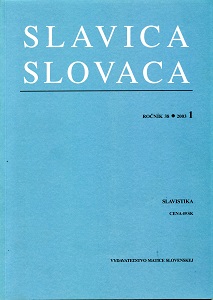Lexikálno-sémantické paralely a odlišnosti základných slovenských a bulharských slovies pohybu
Lexical-Semantic Parallels and Differences between the Basic Verbs of Motion in the Slovak and Bulgarian Languages
Author(s): Nadka Nikolova, Martina ČeripkováSubject(s): Language studies
Published by: SAV - Slovenská akadémia vied - Slovenský komitét slavistov a Slavistický ústav Jána Stanislava SAV, v.v.i.
Keywords: Slavonic (Slavic) Studies; The Slovak and Bulgarian Languages; Linguistics; Verbs of Motion;
Summary/Abstract: The authors investigate on a comparative basis the semantic content of verbs of motion in the Bulgarian and Slovák languages. For them, the Bulgarian language represents the starting point of comparison. So, the verbs xoda, e'bpea, muuaM, ÔRZCIM, xeitpua, nemu are compared to the respective verbs of motion in Slovák. The authors reveal similarities and dissimilarities in both languages and characterize them from the point of view of their semantic peculiarities as well as semantic context. Their analysis of the individual lexemes leans on the compre-hensive ontological-gnoseological approach of J. Dolník which they support by contextual approach, determining the meaning of words by their contextual relations. This kind of research can be conveniently applied in finding the optimal solutions in lexicographical treatment of a language, both in the form of an explicative dictionary or a bilingual translation dictionary.
Journal: Slavica Slovaca
- Issue Year: 38/2003
- Issue No: 01
- Page Range: 29-36
- Page Count: 8
- Language: Slovak

